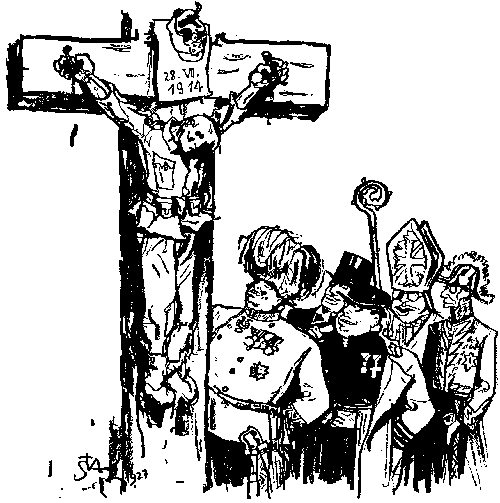![]() From our 'War Picture of the Week' Archive
From our 'War Picture of the Week' Archive ![]()

Austrian war veteran and artist Arthur Stadler (1892-1937) drew this crucifixion of a soldier in 1927.
Stadler left us no explanation of his drawing. Yet the meaning of it seems clear. The generals, the nobility, the clergy, the aristocrats, the rich merchants, they all wanted the ordinary man to fight a glorious and profitable war. The ruling classes didn't mind soldiers suffering and dying, as long as it served their purposes.
 The date on the cross ? July 28, 1914 ? points to the start of the Great War. Stadler made the uniform of the soldier and the clothing of the onlookers unrecognizable. You cannot tell their nationality; all belligerent countries crucified their young men.
The date on the cross ? July 28, 1914 ? points to the start of the Great War. Stadler made the uniform of the soldier and the clothing of the onlookers unrecognizable. You cannot tell their nationality; all belligerent countries crucified their young men.
He was not the only artist that used a crucifixion as a metaphore for the war. Artistically he might have been inspired by the drawing on the right, made in 1918 by Louis Raemaekers, son of a Dutch newspaper editor. Raemaker's drawings appeared in newspapers and magazines all over the world (not in German media though). Click on it to see it larger and compare it to Stadler's drawing.
Arthur Stadler made more grim war drawings. Look at his Fear and his Thorns, terrible recollections of his time at the front.
CRUCIFIXION ? During the Great War one of the most persistant stories was the allied accusation that German soldiers actually crucified a Canadian soldier.
![]() Click on the picture to see the next one in this series
Click on the picture to see the next one in this series
![]() To the index pages of the War Pictures of the Week
To the index pages of the War Pictures of the Week
![]() To the frontpage of The Heritage of the Great War
To the frontpage of The Heritage of the Great War